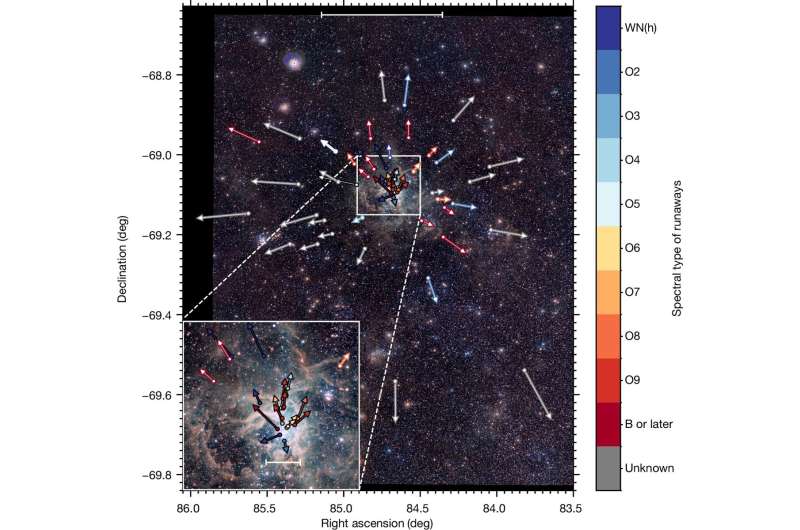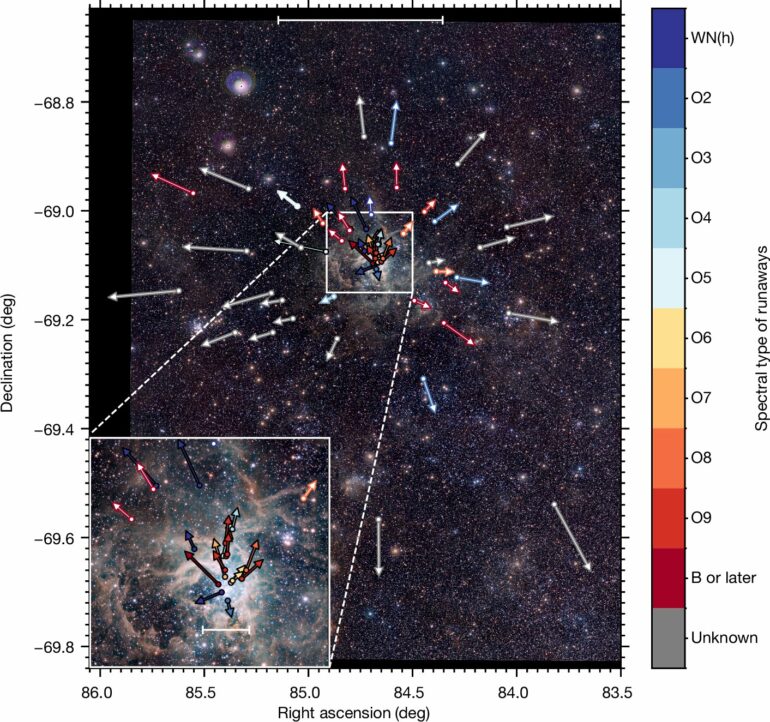Astronomers have used data from the European Gaia Space Telescope to discover 55 high-speed stars launched from the young star cluster R136 in the Large Magellanic Cloud, a satellite galaxy of the Milky Way. This increases tenfold the number of known “runaway stars” in this region. The team of astronomers, including Simon Portegies Zwart of Leiden Observatory, published their results this week in Nature.
When star clusters form, near collisions of the closely packed and crisscross moving newborn stars may result in the ejection of stars out of the young cluster. The astronomers, led by UvA Ph.D. student Mitchel Stoop, found that the young cluster R136 has launched as many as a third of its most massive stars in the last few million years, at speeds above 100,000 km/hr. Those stars travel up to 1,000 light years from their birthplace before exploding as supernovas at their end of life, producing a neutron star or black hole.
But Stoop and his colleagues made another surprising discovery: there was not a single period when the stars were dynamically ejected, but two. Stoop explains, “The first episode was 1.8 million years ago, when the cluster formed, and fits with the ejection of stars during the formation of the cluster. The second episode was only 200,000 years ago and had very different characteristics. For example, the runaway stars of this second episode move more slowly and are not shot away in random directions as in the first episode, but in a preferred direction.”
“We think that the second episode of shooting away stars was due to the interaction of R136 with another nearby cluster (that was only discovered in 2012). The second episode may foretell that the two clusters will mix and merge in the near future,” says co-author Alex de Koter (UvA).
Massive stars eventually explode as supernovas. During their lifetime, they are extremely bright—up to more than a million times brighter than the sun—and emit mainly ultraviolet light that ionizes the surrounding hydrogen gas. They live for only a short time (millions of years) and normally still explode in the star-forming region in which they were born. Such a star-forming region consists of clouds of gas and dust that dampen the effect that massive stars have on their surroundings.

On-sky distribution of runaways from R136 in the last 3 Myr. © Nature (2024). DOI: 10.1038/s41586-024-08013-8
This is the first time such a huge number (55) of high-speed stars originating from a single cluster have been found. R136 is a very special cluster, with hundreds of thousands of stars including the most massive stars known (up to 300 times the mass of the sun). It is part—and the “prima donna”—of the largest star-forming region we know of within a radius of five million light years.
“Now that we have discovered that a third of the massive stars are ejected from their birth regions early in their lives—and that they exert their influence beyond those regions—the impact of massive stars on the structure and evolution of galaxies is probably much larger than previously thought. It is even possible that runaway stars formed in the early universe made an important contribution to the so-called re-ionization of the universe caused by ultraviolet light,” says co-author Lex Kaper (UvA).
The astronomers used data from ESA’s Gaia telescope, which measures the positions, distances and velocities of more than a billion stars. Gaia is located far beyond the moon at a distance of 1.5 million kilometers from Earth. The team’s main goal was to test the limits of Gaia’s capabilities. R136 is located in the Large Magellanic Cloud, a sister galaxy to the Milky Way, at a distance of 160,000 light-years. That’s extremely far for Gaia measurements.
“R136 has only just formed (1.8 million years ago) and so the runaway stars could not yet be so far away that it becomes impossible to identify them. If you can find a lot of those stars, you can make reliable statistical statements. This worked out beyond expectations, and we are tremendously pleased with the results. Discovering something new is always a thrill for a scientist,” De Koter concludes.
Incidentally, during his doctoral research (1946), Dutch astronomer Adriaan Blaauw (April 12, 1914—December 1, 2010) found the first indications of the existence of runaway stars, stars moving at high speed through the Milky Way galaxy. With data from first the ESA space mission Hipparcos, which Blaauw co-lead, and now Gaia, star clusters and the motions of runaway stars can be studied in detail.
More information:
Mitchel Stoop et al, Two waves of massive stars running away from the young cluster R136, Nature (2024). DOI: 10.1038/s41586-024-08013-8
Citation:
Astronomers discover dozens of massive stars launched from young star cluster R136 (2024, October 9)



